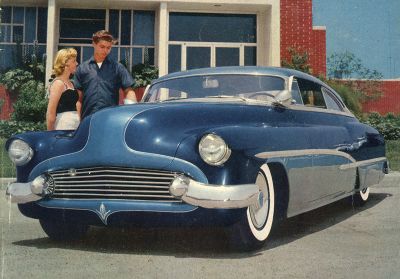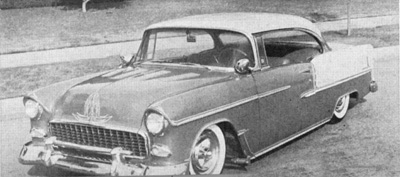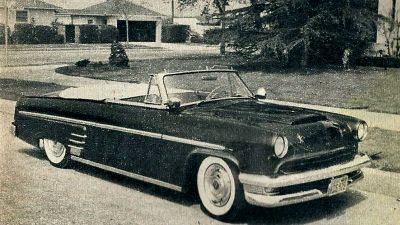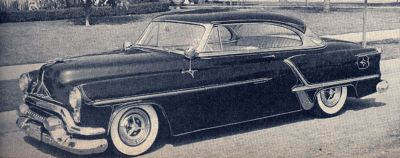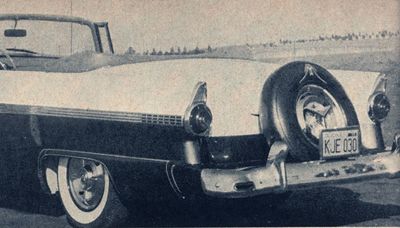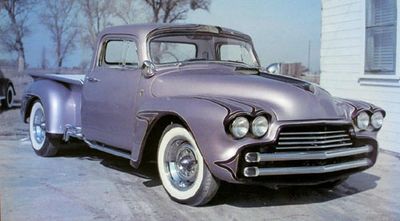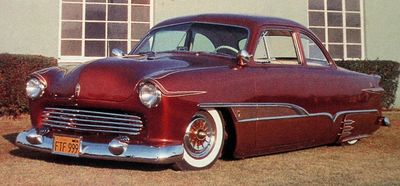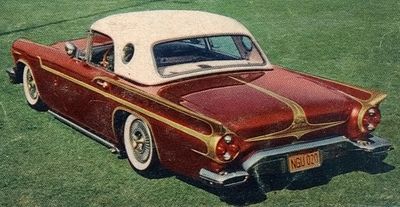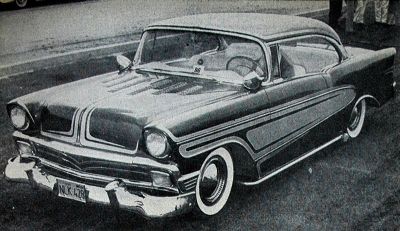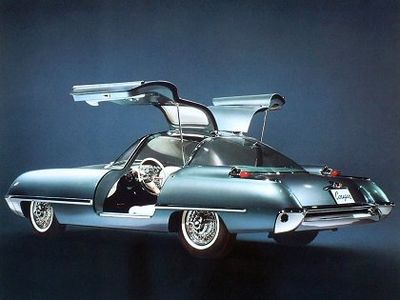Dean Jeffries
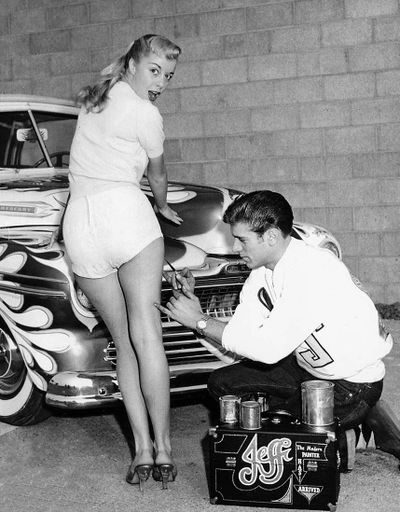



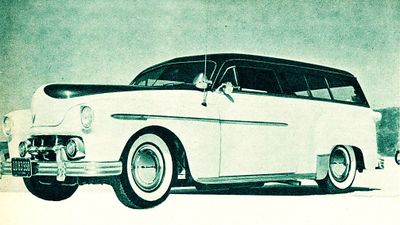

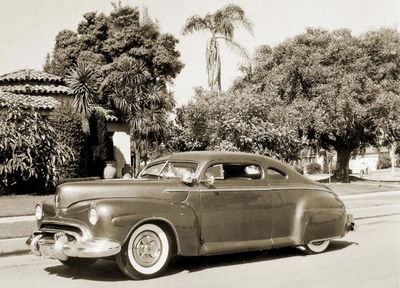


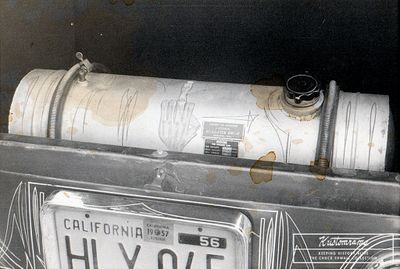





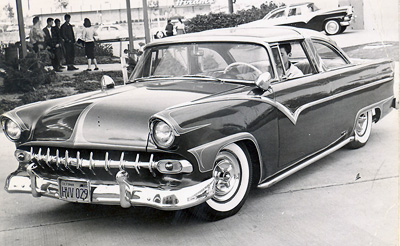
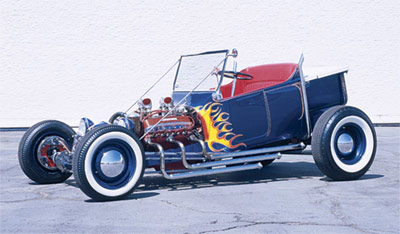
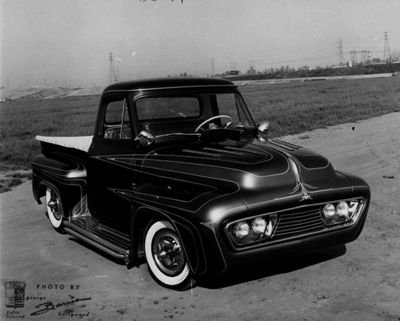


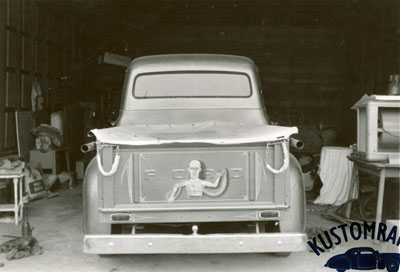
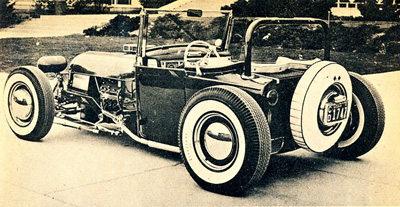

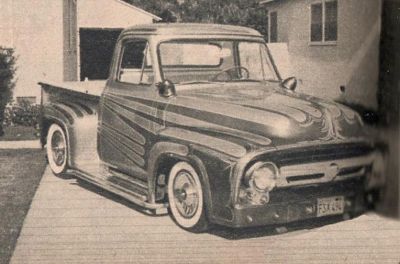



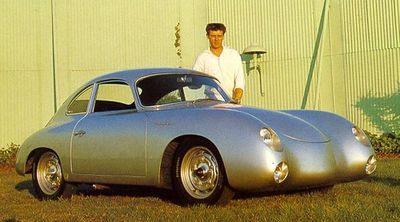









Edward "Dean" Jeffries (February 25, 1933 - May 5, 2013) is a legendary pinstriper, custom painter and custom fabricator. Dean was born in Lynwood, California. As a pinstriper he was known as "The Modern Painter". Dean was the middle child between an older sister, Darlene, and Evon that was born a year later. His father's name was Edward James Jeffries, and his mother's name was Viola Allison Jeffries.[3]
Dean grew up across the street from legendary Indianapolis 500 racer Troy Ruttman. Dean's father Edward was also wrenching on midget racers and race cars, so racing became a passion for Dean early in life. In the book Dean Jeffries 50 Fabulous Years in Hot Rods, Racing and Film Dean tells that throughout his life he has considered himself more a racer than a hot rodder. As his father he was more interested in the design and construction of race cars than in driving them.[3]
Growing up in the Compton area, Dean lived around the corner from Barris Kustoms. After school he used to hang around the shop looking at the cars. He attended Lynwood High with Dick Jackson, who also hung around the shop.[4]
Jeffries left high school at the age of 17, through a special arrangement with the armed services Dean left school and went directly in to the army. Dean was sent to the U.S. facilities in Sanhoffen, Germany where he was assigned as a map maker. During his time in Sanhoffen Dean bought his first car, an old Horch. He used the car to tour Europe in the weekends.[3]
During his stay in Germany Dean became friend with an older German man who painted stripes on pianos and custom furniture. The man thought Dean the art of striping using thin brushes and a steady hand. Once Dean had learned the trade it didn't take long time before his Horch was pinstriped from bumper to bumper. Dean was now eager to return to Lynwood and start his own business. By doing some repair work for an officer in the map department, Dean was able to return home after only one year.[3]
Back home Dean got a job in the evening at a machine shop in Compton, California. The job learned him to operate milling machines, lathes, and drill presses. Dean worked night so he could spend his days looking over the shoulders of masters like George Cerny, Sam Barris, and Von Dutch. Dean spent a lot of time around Von Dutch, and the pair became known as Von Dutch and "The Kid". In the book Dean Jeffries 50 Fabulous Years in Hot Rods, Racing and Film Dean is quoted saying that he really learned striping from Von Dutch. At the time Von Dutch working at a motorcycle shop in Compton.[3]
Dean began to hang out with Kenny Howard way before he started to call himself Von Dutch. Kenny used to paint a third eyeball on his forehead. This gave Jeffries an idea, and in 1951 he designed a logo with an eyeball and wings that he later trademarked. The logo is known as "the Flying Eyeball". Kenny kept using it, and Jeffries never bothered to make a deal out of it. Jeffries still owns the right today, but somebody else is making big bucks out of the design together with the Von Dutch Brand.[3] According to Von Dutch's sister Virginia Howard Reyes, Ed Roth created another version of the "Flying Eyeball" before Dean Jeffries. Dean Jeffries drew one with a roller skate on it, Jeffries eyeball is his own creation and not the same as Von Dutch's, and no one is fighting over Jeffries eyeball because it never became as popular as Von Dutch.[5]
Hanging around George Cerny's shop, George asked if Dean could stripe a boat. The job came out okay, so George asked if he could stripe his 1950 Plymouth wagon. The wagon was the second thing Jeffries ever striped. After that the work became a steady flow. He was still working nights at the machine shop, but he was striping at Cerny's Custom Shop during the day. At the time Jeff and Von Dutch were the only one doing modern striping. The Baron and Ed Roth came along soon after. One day George Barris called "Jeff" and asked if he could pinstripe a car for him. The car turned out to be Johnny Zupan's 1949 Mercury which Barris Kustoms had just two-toned in metallic gold and rust. After he had pinstriped the car, George aksed if Dean would work for him. Dean said that he didn't want to work for him, but that he would gladly rent some space from him. George agreed, and Dean moved in to a little spot next door to the Barris Kustoms shop in 1956.[4] Jeffries had now becomen the Barris Kustoms "house striper." Von Dutch had worked as Barris Kustoms "house striper" until Jeffries' arrival, but according to Hersh Conway, Von Dutch was too moody.[3] George Cerny wasn't too happy about Dean moving out, but he could make more money working out of Barris Kustoms, because when Cerny went home, Dean also had to go home. At Barris Kustoms he could work whenever he wanted, and as long as he wanted.[4]
Jeffries' scallop, pinstripe, and flame painting business grew once he moved next door to Barris Kustoms, and a lot of the cars he painted got coverage on magazine covers. In addition to painting and striping cars, Dean was also early into custom airbrushing on T-shirts at car shows in order to earn some extra bucks. One day as he was pinstriping a boat he added a little character to it. People seemed to like it, so from that he started to add artwork to his striping. After that he learned to airbrush, and started painting T-shirts and sweatshirts. Dean did actually start to airbrush custom T-shirts and sweatshirts way before Ed Roth. Jeffries' continued attending car shows and customizing T-shirts and sweaters into the 1960s.[3]
While being the "house painter" at Barris Kustoms, Jeffries was able to learn all he wanted about metal shaping and fabrication. Jeffries never became an employee at Barris Kustoms, but he became a contractor taking in his own business as well as jobs Barris would throw his way. One of the cars he worked on at Barris Kustoms was Clarence Catallo's 1932 Ford 3-Window Coupe, also known as the Little Deuce Coupe.[3]
James Dean and Dean Jeffries shared a passion for car racing. This passion made them become friends, and Jeffries actually painted the No. 130 and the name "Little Bastard" on James Dean's 1955 Porsche 550 Spyder. Jeffries also pinstriped Dean's helmet.[3]
December 7, 1957, after a hard day in the shop, Jeffries went over to the restaurant across the street from the Barris Kustoms Shop for a supper. As he started to eat he heard someone yell "FIRE!". Jeffries put his jacket over his head and ran into the burning building saving his girlfriend Carol Lewis' 1956 Chevrolet from the flames. The firefighters managed to stop the fire just short of the Ala Kart. 14 cars were destroyed in the fire, including the Wild Kat, Jayne Mansfield's Jaguar, and Archie Moore's Jaguar[6]. After the shop fire George had Gene Simmons take over as general manager so that George could concentrate on getting the business back in order. One section of the shop was not touched by the fire, so he set up the workshop there and renovated the rest of the shop. George also extended the shop out back, and added space up front for a Kustom Accessories store and pinstriping shop that he continued to rent out to Dean Jeffries. The walls were beginning to close in on Jeffries, and he saw a demand for his business growing to compete with Barris instead of complementing Barris. Jeffries pulled up stakes and moved his shop to Hollywood. A move that would help start his extremly successful career building cars for movies.[3]
In 1960, Jeffries' advertised the silver pearlescent version of his customized Porsche for sale in Road & Track September 1960. By then, his shop, named Jeffries Studio of Style, was located at 5807 Sunset Blvd., in Hollywood, California.[7] Dean married Judy Maxson. The marriage didn't last long, but they had time to give birth to a son. Kevin Dean Jeffries was born on November 24, 1960. Dean and Judy were divorced in 1971. Dean kept in thouch with Judy's parents after the marriage, (her father was a wealthy racing enthusiast), and they actually helped him a buy the shop and tools for his new venture in Hollywood. Jeffries tried two locations on Sunset Boulevard before moving out to Cahuenga Boulevard. Jeffries was still in 2013 located on Cahuenga Boulevard. Jeffries called his new venture Jeffries Studio of Style. In his new shop Jeffries painted and pinstriped cars, he also began metal forming, and in addition to this he also sold pinstring brushes and supply for home stripers, as well as custom "mod" sunglasses.[3]
Dean Jeffries was the first person to apply a Metalflake paintjob. The Metalflake Corporation of America came up with the idea of putting small aluminum flakes into paint. The problem was that nobody could get the flakes to come out of the gun in a smooth, consistent pattern. Jeffries experimented with the spray gun and managed the flotation of the flakes by working at a higher pressure. The first car he painted in Metalflake, and the first car ever to be painted in Metalflake was Dick Scritchfield's 1932 Ford Roadster.
Dean Jeffries is known as the first person to apply a Metalflake paintjob. The Metalflake Corporation of America came up with the idea of putting small aluminum flakes into paint. The problem was that nobody could get the flakes to come out of the gun in a smooth, consistent pattern. Jeffries experimented with the spray gun and managed the flotation of the flakes by working at a higher pressure. The first car he supposedly painted in Metalflake, and the first car ever to be painted in Metalflake was Dick Scritchfield's 1932 Ford Roadster.[3] That is not correct, as Dick Scritchfield painted the roadster in Metalflake himself. According to Dick, the Metalflake was painted in Eagle Rock, California, at a friend's body shop. Dick used two toners to arrive at the exact color he wanted. Rather than using gold Metalflake as base for the Candy Apple Red, Dick used silver Metalflake, with the final color coming closer to magenta or cherry red. After painting the car, Tex Smith thought it would be a good idea to drive the car down to Dean Jeffries for a photo shoot. As the photo shoot was done at Jeffries' shop, many thought it was Jeffries that applied the Metalflake on the car. That was not the case. In 2013 Dick told Kustomrama that "Dean was a great guy, and he could have painted it, but he didn't. It was at a time where I was learning and doing most of the work myself, since money was tight in those days."[8]
In 1963, while in his Sunset Boulevard location Jeffries built his most famous car, the Mantaray. Jeffries built the car in order to prove that he was capable of competing head to head with customizers such as George Barris and Gene Winfield. The Mantaray was a major success at the 1964 National Roadster Show. In 1963 Jeffries restyled a brand new Ford Falcon for the Custom Car Caravan as well. The car was called the Falcon Python.[3]
In 1968 Jeffries designed and built dune buggy called the Kyote. The first generation of Jeffries' buggies were called Mantaray II Kyote. An altered version of the Mantaray II Kyote was launched as the Kyote I, and went into production in 1969. When he manufactured the buggies, Jeffries had about 15 people working for him. Around 1100 buggies were turned out of the shop on Caluhenga Boulevard. About 500 Kyote I models, and about 600 Kyote II models. This resulted in the movie and stunt vehicle and hot rod business temporarily had to be pushed to the side.[3]
In 1982 Jeffries married his second wife Rosalie Berman. Rosalie and Dean was together until Rosalie died in September 2008.[3]
Jeffries and George Barris have had a personal and professional rivalry for the past four decades. This rivalry is based on Barris taking credit for custom cars that Jeffries has built. One example is one of the two Monkeemobiles that Jeffries built. George Barris bought one of these. After buying the car he went to the people who make toys and models and hustled them into taking Jeffries name off the boxes and putting his name on it instead. The facts inside the boxes were also changed to saying that Barris built the car. George has also listed the car on his webpage as a custom car by Barris.[3]
Dean passed away at home on Sunday, May 5, 2013.[9]
Contents
Dean Jeffries' Personal Rides
Dean Jeffries' Horch
Dean Jeffries' 1933 Ford Tudor
Dean Jeffries' 1947 Mercury
Johnny Zupan's 1949 Mercury
Dean Jeffries' 1956 Porsche 356
Dean Jeffries' 1957 Ford Ranchero
Dean Jeffries' 1959 Cadillac
Dean Jeffries' 1965 Ford GT Competition Prototype Roadster
Cars Built or Restyled by Dean Jeffries
The Mantaray
The 1962 Ford Cougar 406
Lee Jue's 1965 Ford Thunderbird
The Falcon Python
The Monkeemobile
The Black Beauty
Cars Painted or Pinstriped by Dean Jeffries
Norm Grabowski's 1922 Ford Model T Bucket - The Lightning Bug / The Kookie T
W. L. Scott's 1925 Ford Model T Roadster
Jerry Woodward's 1929 Ford Model-A Roadster
George Sein's 1932 Ford 5 Window Coupe - The Flamer
Jim Griepsma's 1934 Ford 3-Window Coupe
Ron Guidry's 1936 Ford 5-Window Coupe
Tom Hocker's 1940 Ford Coupe
George Janich's 1941 Ford
Bill Polk's 1949 Ford
James J. Pacera's 1949 Ford Tudor
George Cerny's 1950 Plymouth Wagon
Lyle Lake's 1952 Buick Riviera - The Blue Danube
Mando's 1950 Chevrolet
Larry Lorenzo's 1950 Mercury Convertible
Philip Sauers' 1951 Mercury - Sashta
Ed Russell's 1952 Mercury
Jim Doyle's 1952 Mercury Convertible
Buck Gallegos' 1953 Mercury
Bill and Bob Glazier's 1953 Oldsmobile Super 88 Convertible - The Candy Wagon
Joe Gruppie's 1953 Oldsmobile
Herb Conway's 1954 Mercury
Bob Baker's 1955 Chevrolet Bel Air
George Long's 1955 Chevrolet
James Dean's 1955 Porsche 550 Spyder
Frank Monteleone's 1956 Ford
Mandy Holder's 1951 Mercury
The Agajanian Special
Junior Conway's 1950 Ford
Johnny Zupan's 1949 Mercury
Sandy Kroll's 1953 Chevrolet
Martin Srabian and Morris Srabian's 1954 Ford Pickup - The Wild Kat
Butch Johnson's 1954 Mercury Convertible
Bob Baker's 1955 Chevrolet
George Long's 1955 Chevrolet
Bill Burnett's 1955 Ford Crown Victoria
George Contaoi's 1955 Ford F-100
Richard Axcell's 1955 Ford F-100
Carol Lewis' 1956 Chevrolet Bel Air
John Benson's 1956 Chevrolet
Johnny Zupan's 1956 Ford F-100[10]
Dick Jackson's 1957 Ford
Dick Jackson's 1957 Ford Thunderbird
Bill Merrill's 1959 Chevrolet Corvette
The Ala Kart
Anne De Valle's 1942 Ford
Rod & Custom Magazine’s Dream Truck
Dragsters painted or pinstriped by Dean Jeffries
People Working for Dean Jeffries
References
- ↑ The Magnetic Brain - Studio of Style
- ↑ Car Scoops - If You’re A Millionaire, You’ll Want This 1965 Ford GT Prototype
- ↑ 3.00 3.01 3.02 3.03 3.04 3.05 3.06 3.07 3.08 3.09 3.10 3.11 3.12 3.13 3.14 3.15 3.16 Dean Jeffries 50 Fabulous Years in Hot Rods, Racing and Film
- ↑ 4.0 4.1 4.2 Barris Kustom Techniques of the 50's Volume 4
- ↑ Virgina Howard Reyes
- ↑ Barris Kustoms of the 2950s
- ↑ Road & Track September 1960
- ↑ Dick Scritchfield
- ↑ Kevin Dean Jeffries
- ↑ Custom Cars of the 1950s
Did you enjoy this article?
Kustomrama is an encyclopedia dedicated to preserve, share and protect traditional hot rod and custom car history from all over the world.
- Help us keep history alive. For as little as 2.99 USD a month you can become a monthly supporter. Click here to learn more.
- Subscribe to our free newsletter and receive regular updates and stories from Kustomrama.
- Do you know someone who would enjoy this article? Click here to forward it.
Can you help us make this article better?
Please get in touch with us at mail@kustomrama.com if you have additional information or photos to share about Dean Jeffries.
This article was made possible by:
SunTec Auto Glass - Auto Glass Services on Vintage and Classic Cars
Finding a replacement windshield, back or side glass can be a difficult task when restoring your vintage or custom classic car. It doesn't have to be though now with auto glass specialist companies like www.suntecautoglass.com. They can source OEM or OEM-equivalent glass for older makes/models; which will ensure a proper fit every time. Check them out for more details!
Do you want to see your company here? Click here for more info about how you can advertise your business on Kustomrama.


